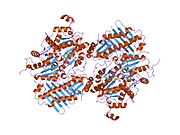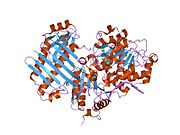Biology:CASC3
From HandWiki
 Generic protein structure example |
Protein CASC3 is a protein that in humans is encoded by the CASC3 gene.[1][2][3]
Function
The product of this gene is a core component of the exon junction complex (EJC), a protein complex that is deposited on spliced mRNAs at exon-exon junctions and functions in nonsense-mediated mRNA decay (NMD). The encoded protein binds RNA and interacts with two other EJC core components. It is predominantly located in the cytoplasm, but shuttles into the nucleus where it localizes to nuclear speckles.[3]
References
- ↑ "Identification of four novel human genes amplified and overexpressed in breast carcinoma and localized to the q11-q21.3 region of chromosome 17". Genomics 28 (3): 367–76. Jan 1996. doi:10.1006/geno.1995.1163. PMID 7490069.
- ↑ "Genomic analysis of the HER2/TOP2A amplicon in breast cancer and breast cancer cell lines". Lab Invest 88 (5): 491–503. Apr 2008. doi:10.1038/labinvest.2008.19. PMID 18332872.
- ↑ 3.0 3.1 "Entrez Gene: CASC3 cancer susceptibility candidate 3". https://www.ncbi.nlm.nih.gov/sites/entrez?Db=gene&Cmd=ShowDetailView&TermToSearch=22794.
External links
- Human CASC3 genome location and CASC3 gene details page in the UCSC Genome Browser.
Further reading
- Varis A; Wolf M; Monni O et al. (2002). "Targets of gene amplification and overexpression at 17q in gastric cancer". Cancer Res. 62 (9): 2625–9. PMID 11980659.
- Degot S; Régnier CH; Wendling C et al. (2002). "Metastatic Lymph Node 51, a novel nucleo-cytoplasmic protein overexpressed in breast cancer". Oncogene 21 (28): 4422–34. doi:10.1038/sj.onc.1205611. PMID 12080473.
- Strausberg RL; Feingold EA; Grouse LH et al. (2003). "Generation and initial analysis of more than 15,000 full-length human and mouse cDNA sequences". Proc. Natl. Acad. Sci. U.S.A. 99 (26): 16899–903. doi:10.1073/pnas.242603899. PMID 12477932. Bibcode: 2002PNAS...9916899M.
- Macchi P; Kroening S; Palacios IM et al. (2003). "Barentsz, a new component of the Staufen-containing ribonucleoprotein particles in mammalian cells, interacts with Staufen in an RNA-dependent manner". J. Neurosci. 23 (13): 5778–88. doi:10.1523/jneurosci.23-13-05778.2003. PMID 12843282.
- Ota T; Suzuki Y; Nishikawa T et al. (2004). "Complete sequencing and characterization of 21,243 full-length human cDNAs". Nat. Genet. 36 (1): 40–5. doi:10.1038/ng1285. PMID 14702039.
- "An eIF4AIII-containing complex required for mRNA localization and nonsense-mediated mRNA decay". Nature 427 (6976): 753–7. 2004. doi:10.1038/nature02351. PMID 14973490.
- Degot S; Le Hir H; Alpy F et al. (2004). "Association of the breast cancer protein MLN51 with the exon junction complex via its speckle localizer and RNA binding module". J. Biol. Chem. 279 (32): 33702–15. doi:10.1074/jbc.M402754200. PMID 15166247.
- Gerhard DS; Wagner L; Feingold EA et al. (2004). "The status, quality, and expansion of the NIH full-length cDNA project: the Mammalian Gene Collection (MGC)". Genome Res. 14 (10B): 2121–7. doi:10.1101/gr.2596504. PMID 15489334.
- "Mammalian Staufen1 recruits Upf1 to specific mRNA 3'UTRs so as to elicit mRNA decay". Cell 120 (2): 195–208. 2005. doi:10.1016/j.cell.2004.11.050. PMID 15680326.
- Ballut L; Marchadier B; Baguet A et al. (2005). "The exon junction core complex is locked onto RNA by inhibition of eIF4AIII ATPase activity". Nat. Struct. Mol. Biol. 12 (10): 861–9. doi:10.1038/nsmb990. PMID 16170325.
- "Biochemical analysis of the EJC reveals two new factors and a stable tetrameric protein core". RNA 11 (12): 1869–83. 2006. doi:10.1261/rna.2155905. PMID 16314458.
- Kimura K; Wakamatsu A; Suzuki Y et al. (2006). "Diversification of transcriptional modulation: large-scale identification and characterization of putative alternative promoters of human genes". Genome Res. 16 (1): 55–65. doi:10.1101/gr.4039406. PMID 16344560.
- "Mutational analysis of human eIF4AIII identifies regions necessary for exon junction complex formation and nonsense-mediated mRNA decay". RNA 12 (3): 360–74. 2006. doi:10.1261/rna.2190706. PMID 16495234.
- Andersen CB; Ballut L; Johansen JS et al. (2006). "Structure of the exon junction core complex with a trapped DEAD-box ATPase bound to RNA". Science 313 (5795): 1968–72. doi:10.1126/science.1131981. PMID 16931718.
- Olsen JV; Blagoev B; Gnad F et al. (2006). "Global, in vivo, and site-specific phosphorylation dynamics in signaling networks". Cell 127 (3): 635–48. doi:10.1016/j.cell.2006.09.026. PMID 17081983.
- Baguet A; Degot S; Cougot N et al. (2007). "The exon-junction-complex-component metastatic lymph node 51 functions in stress-granule assembly". J. Cell Sci. 120 (Pt 16): 2774–84. doi:10.1242/jcs.009225. PMID 17652158.





